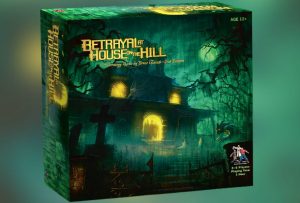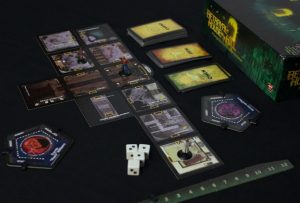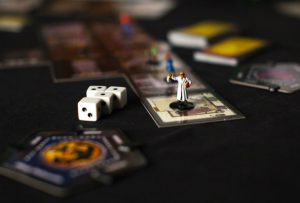Tabletop Game Review: Betrayal at House on the Hill
Some people start their tabletop boardgaming careers with Settlers of Catan. For my Brooklyn group, it was Betrayal at House on the Hill. I don’t know who they chained up in a basement to write all of them, but this game has fifty different scenarios to play through, each with unique win conditions and puzzles. Betrayal is somewhere between Clue and a D&D dungeon crawl in a haunted house, and it’s a perfect game for beginners, as well as older gamers who like storytelling and creepy surprises. The magic of Betrayal is that it’s like a box of chocolates—you never know what you’re gonna get.

What Kind of Game Is It?
Betrayal is an exploration/role-playing game where you take control of one of six characters locked in a spooky old house, though there are technically twelve characters to choose from (Professor Longfellow is my favorite). Over the course of the game, you and your friends discover new rooms and attempt to prepare yourselves for the inevitable beginning of the ‘Haunt,’ the moment when the House’s terrible nature is revealed and one of your party is turned into the Traitor. Until then, all of you are trying to make yourselves more powerful by boosting your stats and collecting items through random encounters in the House.
What’s The Gameplay Like?
At the beginning of the game, there are only three rooms: the Foyer, the Second Floor Landing, and the Basement Landing. As the characters take turns exploring the House, they draw random “room tiles” and connect them to other rooms, effectively building the house as they go.
Almost every room forces the player to draw a random Event, Omen, or Item card, which can help or harm the player. Most of the events are something suitably spooky, like finding a coffin with your doppelganger in it or seeing a vision of corpses hanging from the ceiling, but some are unexpectedly helpful, like finding a mirror where your reflection reaches through to hand you an item. Most of them are essentially skill challenges, where a success means gaining power and a fail means slipping closer to death.
Instead of a character sheet, every character has a little pentagonal card with four stats (sanity, intelligence, strength, and speed) that can be used to deal with trials and traps in the House. Some characters are naturally more intelligent, sane, or athletic than others—our running gag is that “Flash” Williams is the Ubermensch of House, since he seems to be good at everything, especially speed. Woe be to the players who have to fight a Traitor Flash.

What Makes It So Fun?
The random construction of the House is definitely one of the highlights, since every game ends up creating a different layout. Plus, Betrayal has all the creepy, supernatural atmosphere of a Gothic novel, but the gameplay is closer to Scooby Doo.
It’s once the Haunt begins, however, that Betrayal really comes alive—there are fifty scenarios in the base set, and each one transforms the game into something totally new. One Haunt forces you to stop a Lovecraftian summoning ritual that will usher an Elder God into our world (“The Stars Are Right”), while another turns the Traitor into a giant, growing Ouroboros that slithers through the rooms (“The Worm Ouroboros”). My favorite is called “Airborne,” the one where a giant bird picks up the House and carries it into the air, forcing the players to fight over parachutes scattered throughout the rooms. Of course, there’s not enough to go around, so someone gets left behind. There’s no Traitor in that one—just your fellow players.

PROS AND CONS:
PROS: Betrayal is easy to teach, easy to play, and has almost endless replayability. The random events and on-the-fly construction of the house keep the minute-to-minute enjoyment high, and the drama that ensues from the Traitor/players dynamic is fun in itself. Add some incredible production values, cool items (my favorite is The Mask), and amazingly imaginative Haunts, and Betrayal is one of the most appealing and accessible tabletop games around.
CONS: Apart from being a pretty long game for higher player counts, the fact that the players and the Traitor have to learn the very specific (and often complex) rules of the Haunt while in separate rooms means that game-breaking miscommunications or misunderstandings can derail an entire session. Also, because the game is random every time, sometimes Betrayal comes across as a horror Mad Lib, though the base game is usually consistent enough to keep you immersed.
FINAL VERDICT:
Despite the occasional misfire, Betrayal is a solid game for players who want to add some mystery, role-playing, and chills to their game night. Best played by candlelight.
Image credits: Avalon Hill, Wizards of the Coast
